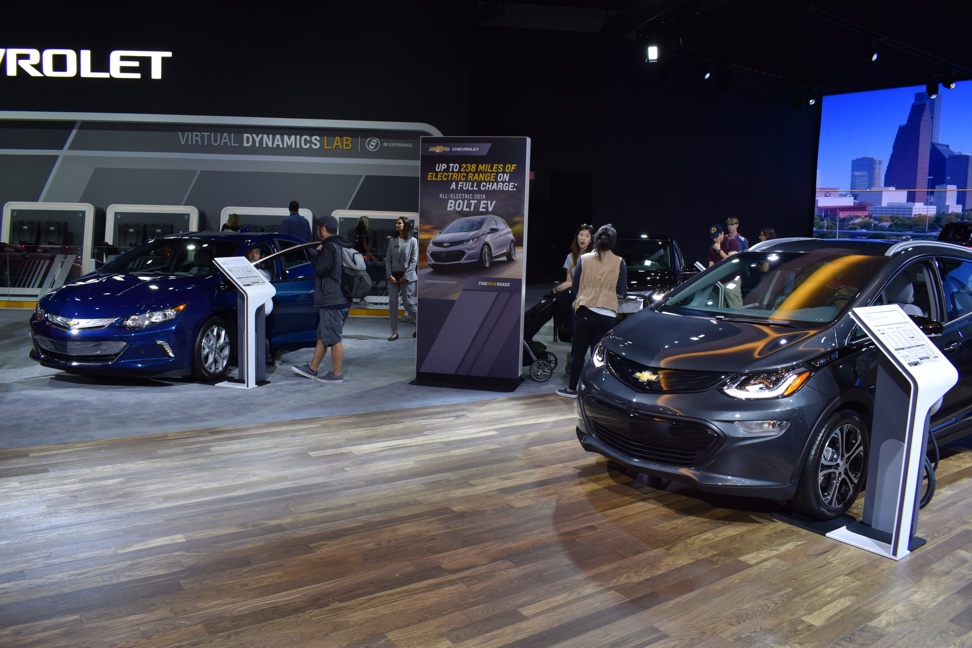
Home - AFV Events - Auto Shows - 2018 L.A. Auto Show
Since California is a leader in alternative-fueled vehicles (AFVs), the Los Angeles Auto Show is the biggest show in the country and maybe the world for rollouts and premieres of new vehicles of the kind I track on this website. Unfortunately, since I moved out of state a decade ago, I have to make a bit more effort to get there, but it's always worth it! As I did last year, I arranged for a long layover in Los Angeles while traveling home from a business trip, rented a car, and drove over for a quick look. I had only three hours at the show this year instead of five as last time, so I didn't get to ask all the questions I'd have liked to, or take any test drives (notably missing Byton, whose only presence was out in the test-drive area); but I still have plenty to report!

The overarching theme seemed to be that trucks are arriving in the AFV world in a big way, just when they are pushing out passenger cars in the overall US market. Ford is going to stop making cars altogether, except for the Mustang, and recently GM announced that it was going to shut down production of a number of its cars. That includes the Chevrolet Volt plug-in hybrid (PHEV), shown here to the left of its battery-only stablemate the Bolt EV. The Volt was the first plug-in vehicle to reach 100,000 sold or leased in the United States, and as of this writing it has the highest cumulative US sales of any plug-in vehicle, PHEV or battery-only, but 2019 will be its last model year. The Bolt EV is continuing, and going strong, and many of the new introductions are of battery-only vehicles; so I wonder if the day of the PHEV might be coming to an end in general, since the increasing ranges of battery-only vehicles are making the backup gasoline capability, and attendant complexity, of a PHEV less and less necessary. "Range anxiety" will soon sound as outdated as "Get a horse!" Well, time will tell.
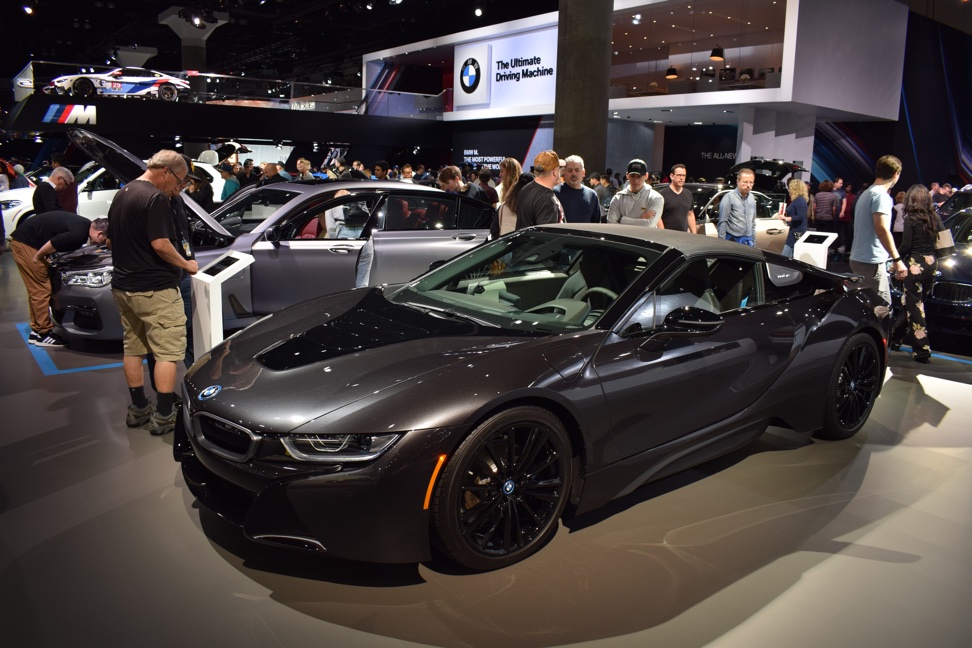
Of course, for now both cars and PHEVs are still going strong overall. BMW had several such vehicles clustered together, with the new i8 Roadster as the centerpiece. Honda had its three Clarity variants (battery-only EV, PHEV, and fuel-cell vehicle or FCV) on display together, and Hyundai has its IONIQ trio (hybrid, PHEV, EV) and Sonata duo (hybrid, PHEV). Toyota showed its new AWD-e (electric all-wheel-drive) option for the 2019 Prius, and while it is currently only available for the non-plug-in hybrid, it may make its way to the PHEV Prius Prime as well.
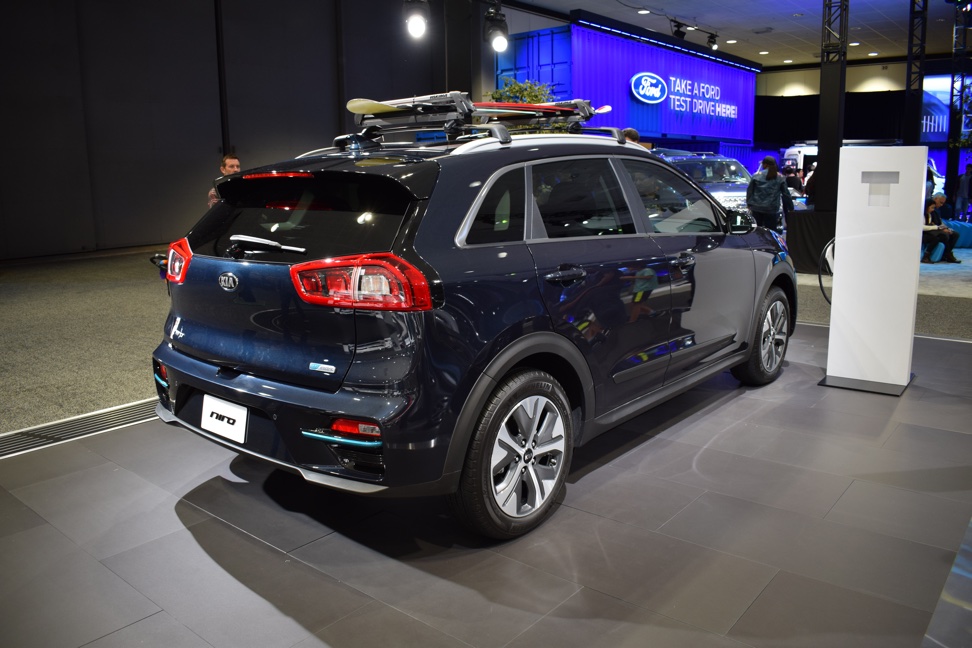
But a lot of the excitement that I've seen in the EV world lately centers around compact SUVs, or CUVs, like this Kia Niro EV that will be available in April 2019 (making its North American debut at this show, and having pride of place on the biggest banner outside around the main hall - and it's pronounced NEAR-o, not NYE-ro, by the way). It has long range and moderate pricing, and I will probably try to sell my wife on getting either this or one of its competitors when we replace what I firmly intend to be our last gasoline vehicle, a 2016 Nissan Rogue. CUVs are a big and growing segment of the US market, and pushing into it with reasonably-priced plug-in models seems likely to be a winner for automakers placing such a bet.
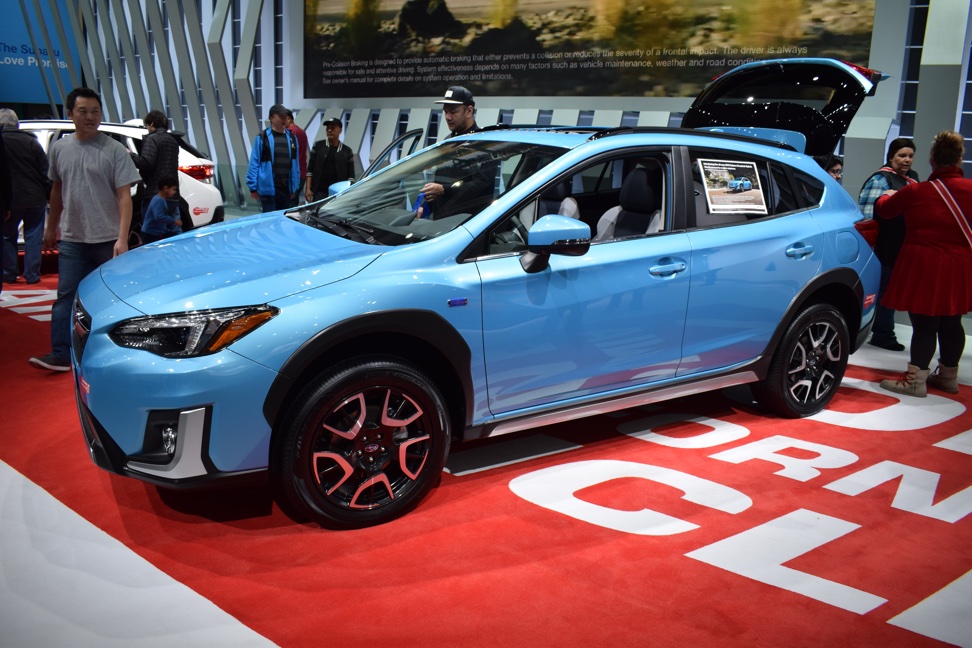
Subaru introduced its first plug-in vehicle, the 2019 Crosstrek PHEV, with all-wheel drive.
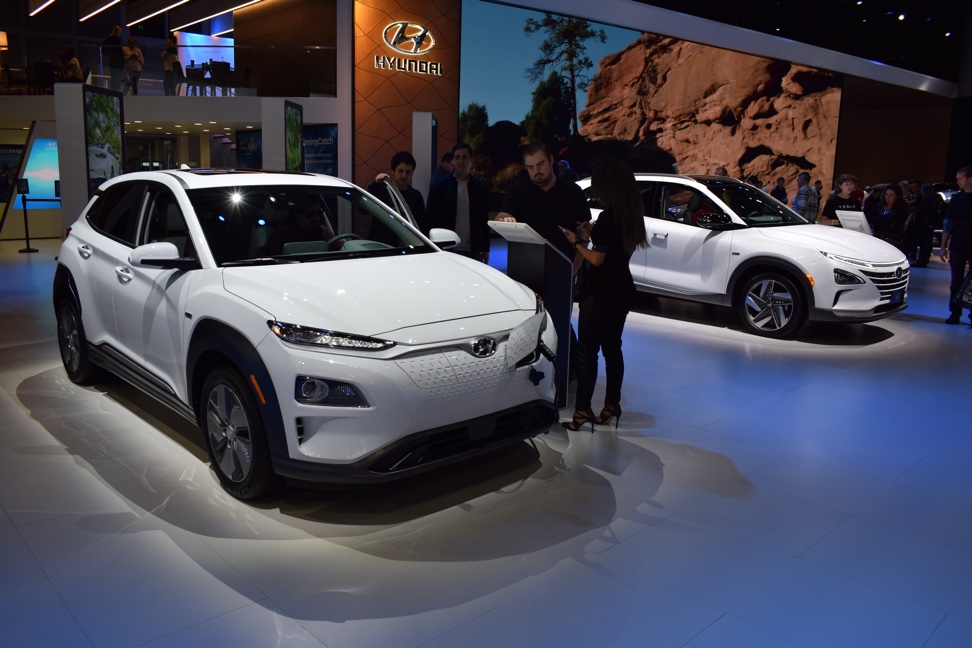
Here is the Hyundai counterpart to the Niro, the Kona EV, and in the background the new Nexo FCV that replaces the Tucson FCV. The Nexo will be available soon "in very limited quantities at select California dealerships only," much like the Tucson; however, I understand that unlike the Tucson (and the Honda Clarity FCV, but like the Toyota Mirai) it will actually be offered for sale, not for lease only. If that turns out to be the case, it's a big deal for those of us who witnessed the fate of the lease-only EVs of twenty years ago.
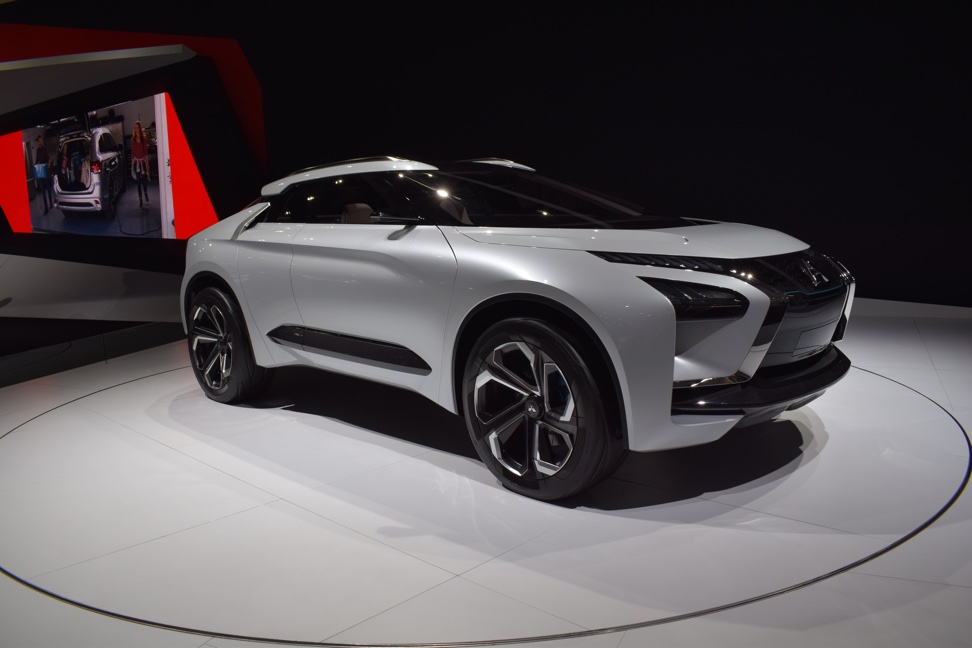
Mitsubishi last year brought its larger Outlander PHEV to the US, a move much anticipated by those of us who saw its success overseas during the last few years. This year they brought to the show, for its North American debut, the e-Evolution concept CUV. This seems to be intended to look forward to a future all-electric production model, though it of course has the radical innovations (notably in the extreme heads-up display for the driver) that can be indulged in a concept vehicle.
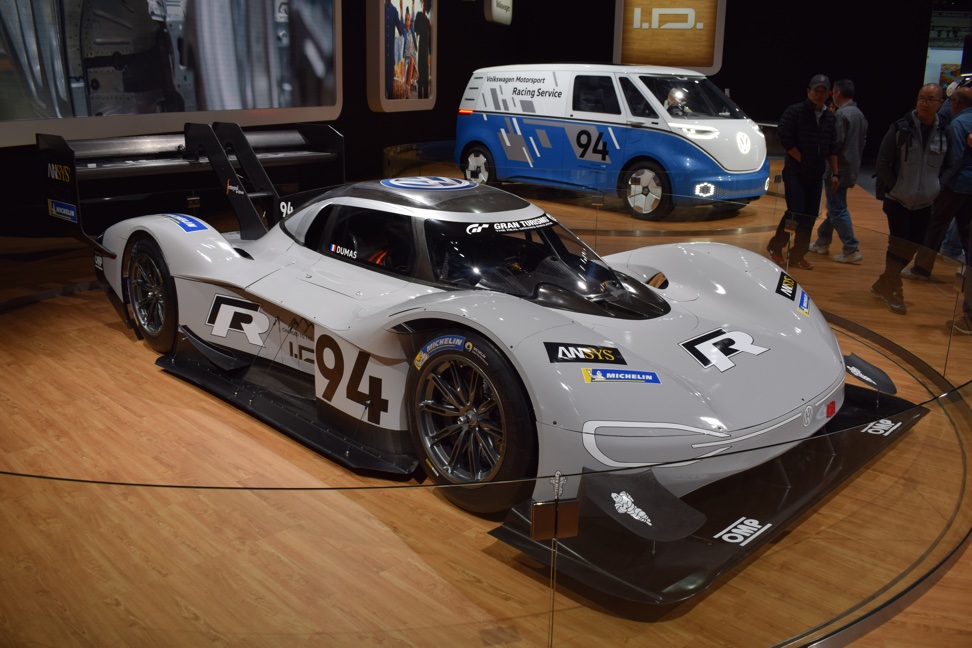
Volkswagen had their e-Golf, but also brought these examples from their new battery-electric ID. lineup. In the foreground is their electric Pike's Peak hill-climb champion, and in the background is the Buzz microbus concept. The yellow Buzz that made the rounds last year was a passenger van, but this one was configured as a panel cargo van, and was used as a support vehicle for the Pike's Peak racer's record-setting run. I just gotta say that I love the lit transparent "VW" logo on the nose - it's the perfect update to the look of the beloved traditional microbus! The dates I reported last year for the introduction of the ID. Crozz crossover and the ID. Buzz, 2020 and 2022 respectively, still seem to be holding; there is still no date for the car displayed at last year's show (called just "ID." as far as I have been able to learn).
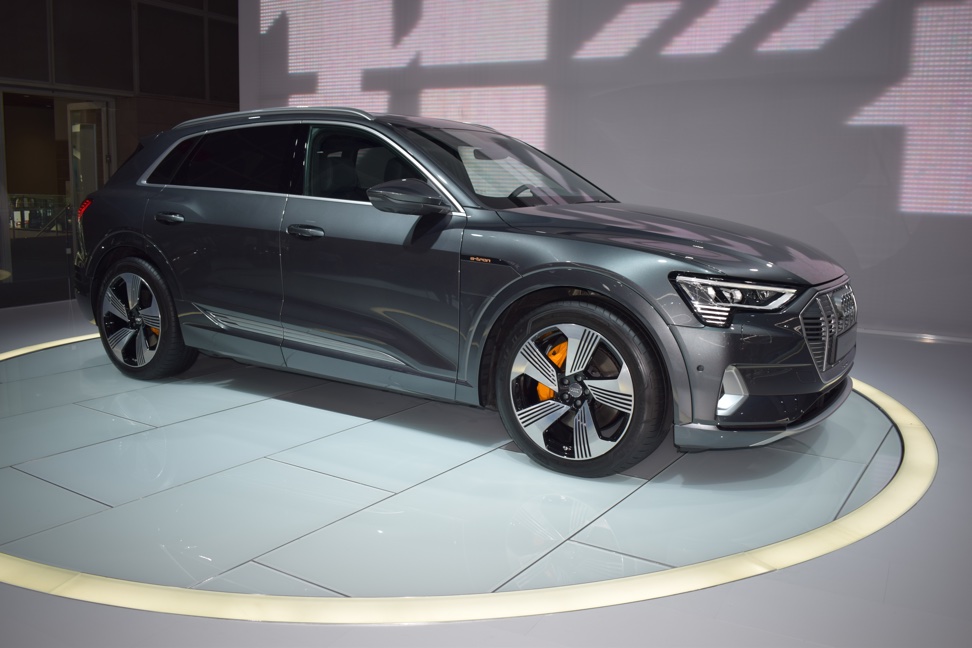
Departing, er, significantly from the realm of "moderate pricing," we have the new Audi e-tron Quattro SUV. You will sometimes read announcements of new models as "[manufacturer] has gone electric"; I thought that Audi made the point nicely that this is still an Audi through and through with the tagline "Electric has gone Audi" instead. Also at the high end of battery-electrics, Jaguar had a display similar to last year's show with their I-PACE SUV and Formula E race car.
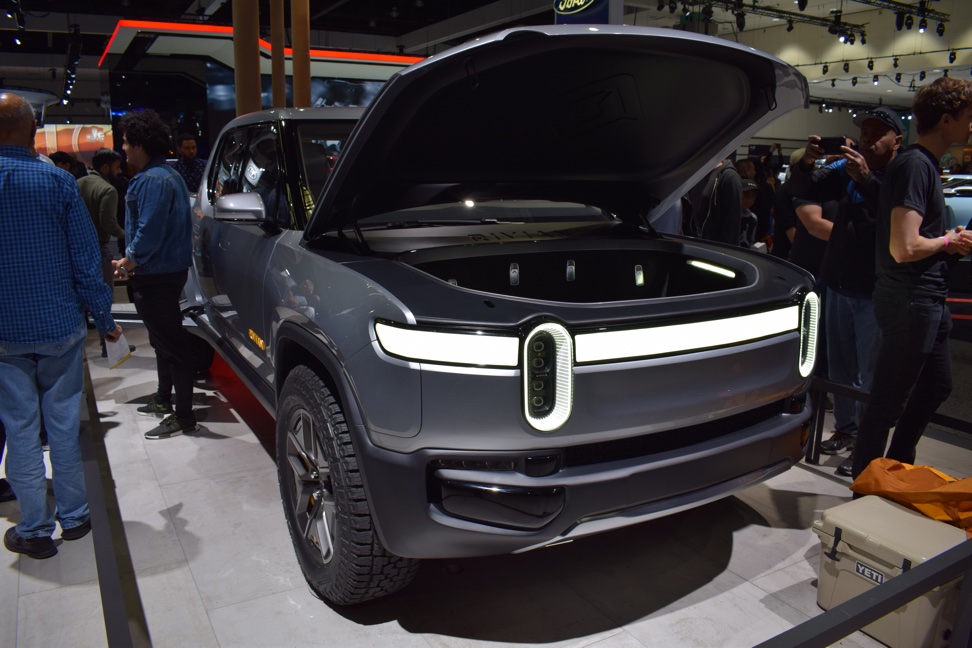
But in spite of the fact that my family is likely to get something like the Crozz, the Niro, or the Kona to replace our last gasoline vehicle, and for all the excitement the EV community feels for the large number of new choices in that important market segment, still most everybody seems to agree with me that the show-stopper at this year's auto show was the debut of Rivian. This company intends to begin the electrification of not one but two categories of vehicles: in the fourth quarter of 2020, they plan to introduce both the R1T large pickup truck, shown in concept form here, and the R1S large SUV. That is, there were many plug-in compact SUVs at this show, and the midsize Outlander PHEV and Tesla Model X are doing well in the market already; in fact, electric versions of compact SUVs and compact pickups go back to the first, abortive modern flowering of electric vehicles 20 years ago, with the Toyota RAV4-EV and the Ford Ranger and Chevy S-10. But full-size trucks are the most popular vehicles in the US market, and Rivian aims to be first to market with powerful, capable electric competitors in the segment.
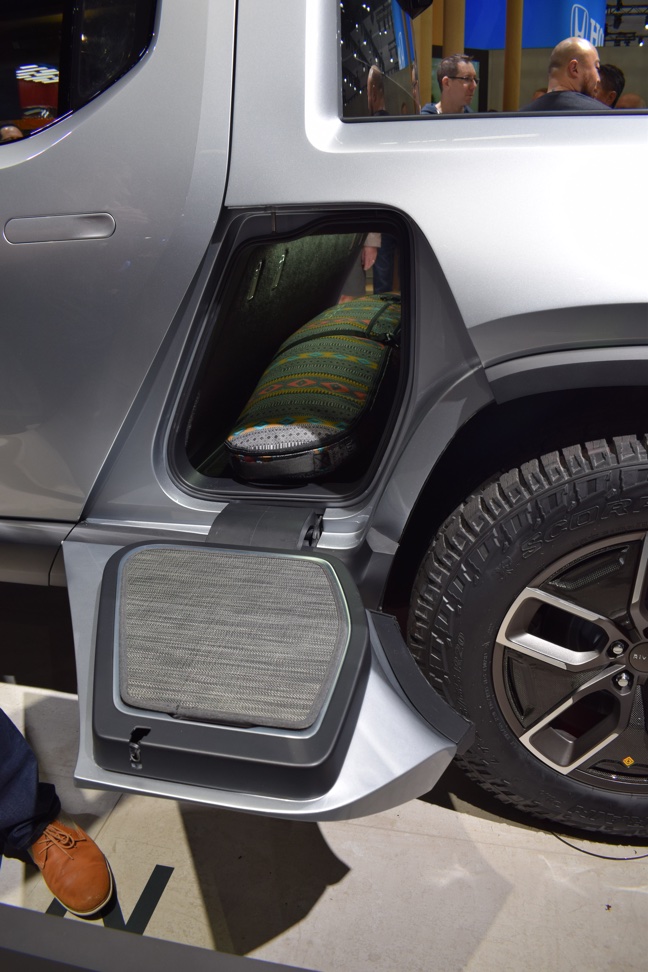
One Rivian rep said that her favorite thing about the vehicle is that, as is clear from the photo of the R1T front above, you can tell immediately what kind of truck you're looking at if you encounter one of these on the road. The most amazing thing to me is that they are expecting an EPA energy-consumption rating of about 2.2 miles per kWh of electricity in routine driving, which is more than half the 4 miles per kWh we get with our little Nissan LEAF! I guarantee you that a gasoline pickup with this kind of performance will get a lot less than half the fuel economy of a compact gasoline car, but the ability to build in performance capability without sacrificing efficiency in everyday driving is an inherent advantage of electric drivetrains. And one rep was particularly proud of this extra sealed storage space going all the way across the vehicle in front of the rear wheels, which is possible due to the space efficiency of a modern electric powertrain. As you can see in the R1T photo above this one, Rivian trucks have a front trunk or "frunk" since they don't have to use the space for an engine bay (there is a motor at each wheel), and though the name mid-trunk or "munk" comes to mind for this unusual storage space, the official name is "gear tunnel."
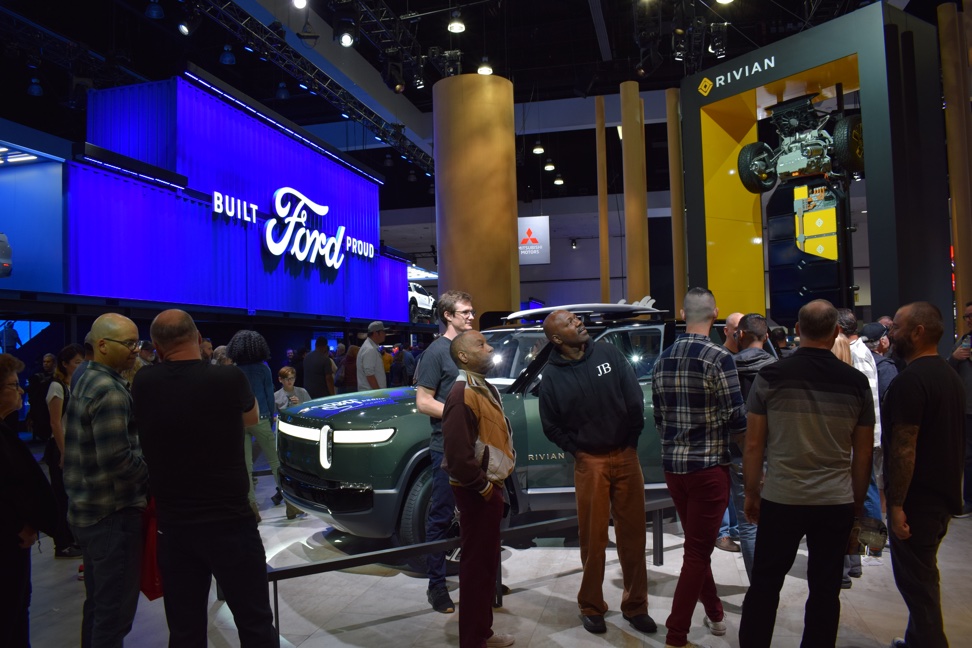
Actually, almost as impressive to me as the promised capabilities of the vehicles themselves is the confidence that the company is displaying. Tesla didn't have a company presence at this major auto show until they put some vehicles in a corridor display two years ago, and they had a space in the main halls for the first time last year (though to be sure, they haven't exactly needed to advertise in order to sell their vehicles!). Rivian, though, broke their "early stage" startup cover by jumping straight to the main halls; and not only that, but they got a space right next to Ford, whose F-Series pickups are the most popular vehicles in the USA and whose range, off-road capability, payload, and towing capacity Rivian is directly challenging! Actually, four-wheel electric motors are planned to give the R1T and (pictured here, obscured by a large crowd of interested folks) R1S some capabilities no internal-combustion truck on the market can match, like a zero-to-sixty time of 3 seconds and the ability to do a "tank turn," with the four wheels spinning independently to rotate the vehicle in place! Pretty in-your-face stuff; I will be watching with great interest to see if they can pull it off, and start the electric repowering of this huge slice of the U.S. vehicle market, over the next couple of years. Exciting times all around!
 Back
to AFV Events Page
Back
to AFV Events Page Back
to Fueling Station
Back
to Fueling Station Site
Map
Site
Map Contact
Me
Contact
Me All content copyright 1998-2024 by Mark Looper, except as noted. Reuse of my copyrighted material is authorized under Creative Commons Attribution 4.0 International license (CC BY 4.0).
![]()
![]()
new 3 December 2018